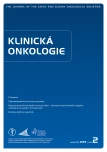Tailoring Nutritional Interventions with Molecular Pathophysiology of Cancer Cachexia – a Possible Solution to an Old Problem
Přizpůsobení nutričních intervencí molekulární patofyziologii nádorové kachexie – jak vyřešit dlouhodobý problém
Autor deklaruje, že v souvislosti s předmětem studie nemá žádné komerční zájmy.
Redakční rada potvrzuje, že rukopis práce splnil ICMJE kritéria pro publikace zasílané do biomedicínských časopisů.
Obdrženo: 20. 12. 2018
Authors:
H. Mortazavi
Published in:
Klin Onkol 2019; 32(2): 157-158
Category:
Letter to Editor
doi:
https://doi.org/10.14735/amko2019157
Overview
Autor deklaruje, že v souvislosti s předmětem studie nemá žádné komerční zájmy.
Redakční rada potvrzuje, že rukopis práce splnil ICMJE kritéria pro publikace zasílané do biomedicínských časopisů.
Obdrženo: 20. 12. 2018
Dear Sir,
Despite significant advances in providing palliative and supportive care to patients undergoing advanced cancer treatment, between 50 and 80% of them suffer from malnutrition and cachexia and approximately 25% of cancer deaths are related to cancer-induced cachexia [1,2]. Cancer-induced cachexia is a chronic, progressive, involuntary loss of skeletal muscle mass that can lead to malnutrition and progressive functional damage of patients who suffer from cancer such that supporting convention-al nutritional regimens cannot revert those pathophysiological changes [3]. Cancer cachexia is associated with anorexia, early satiation, and asthenia and it is pathophysiology characterised by the release of pro-inflammatory cytokines, increase in muscle protein breakdown and negative energy balance due to the reduced food ingestion and abnormal metabolism. In addition, the systemic inflammatory response and the hypermetabolism status following cancer and its treatments can lead to increased resting energy consumption. Furthermore, cancer treatment can cause gastrointestinal motility defects, gastrointestinal mucosal damage, and impaired appetite, which contribute to the deterioration of malnutrition [4].
Cancer cachexia can profoundly diminish the physical function and tolerance to anticancer therapy, and consequently reduce the chance of survival of affected patients. It is associated with increased toxicity from chemotherapy and is a cause of poor outcomes for some patients [1,5]. Hence, cancer cachexia remains a challenging clinical syndrome and an important unmet need in the palliative care of patients who suffer from cancer [1].
Given that preventing loss of muscle mass is an important part of the cancer treatment, cancer-related cachexia should be reversed by either treating the cancer or increasing nutritional intake [3,4]. However, because of the complexity and difficulty of treatment in advanced cancer, increasing the nutritional intake remains one of the only available choices in building and preserving muscle mass in the treatment of cancer cachexia [4,6]. Accordingly, to get the best out of the nutritional interventions, the dietary intake should be matched with the underlying pathophysiology of cancer-associated cachexia and the total demand of protein requirements with the overall health status of patients who suffer from cancer [6]. However, a possible explanation for the high prevalence of cancer-induced cachexia is that limited nutrition-oriented interventions or specialised nutrition support have focused on the presumed pathophysiology of cancer cachexia and many of the current interventions are based on the pathophysiology of chronic diseases-related cachexia [4]. Previous studies showed that early and tailored nutritional intervention might be optimal for these patients in terms of reducing the body weight loss due to the nutrition-associated adverse events [6,7]. Therefore, prior to designing and developing future nutrition-oriented clinical trials, researchers should logically select and adjust the proposed nutritional interventions and tailor those interventions with the established molecular mechanisms underlying cancer-related cachexia, which includes muscle protein breakdown, negative energy balance and abnormal metabolism as well as pro-inflammatory action of reactive oxygen species. In addition, a future study is needed for designing and implementing intensive, personalised nutrition counselling programmes for cachectic cancer patients that theoretically could counteract the assumed pathophysiology.
The author declares he has no potential conflicts of interest concerning drugs, products, or services used in the study.
The Editorial Board declares that the manu script met the ICMJE recommendation for biomedical papers.
Hamed Mortazavi, M.D.
Gerontological Care Research Center
Department of Geriatric Nursing
School of Nursing and Midwifery
North Khorasan University of Medical Sciences
Dowlat Blvd. Bojnurd, 9414975516, Iran
e-mail: mortazaviham@yahoo.com
Submitted: 20. 12. 2018
Sources
1. Vagnildhaug OM, Balstad TR, Almberg SS et al. A cross-sectional study examining the prevalence of cachexia and areas of unmet need in patients with cancer. Support Care Cancer 2018; 26 (6): 1871–1880. doi: 10.1007/s00520-017-4022-z.
2. Gullett NP, Mazurak V, Hebbar G et al. Nutritional interventions for cancer-induced cachexia. Curr Probl Cancer 2011; 35 (2): 58–90. doi: 10.1016/j.currproblcancer.2011.01.001.
3. Solheim TS, Laird BJ, Balstad TR et al. Cancer cachexia: rationale for the MENAC (Multimoda-Exercise, Nutrition and Anti-inflammatory medication for Cachexia) trial. BMJ Support Palliat Care 2018; 0: 1–8. doi: 10.1136/bmjspcare-2017-001440.
4. Sadeghi M, Keshavarz-Fathi M, Baracos V et al. Cancer cachexia: diagnosis, assessment, and treatment. Crit Rev Oncol Hematol 2018; 127: 91–104. doi: 10.1016/j.critrevonc.2018.05.006.
5. Mortazavi H. Could art therapy reduce the death anxiety of patients with advanced cancer? An interesting question that deserves to be investigated. Indian J Palliat Care 2018; 24 (3): 387–388. doi: 10.4103/IJPC.IJPC_7_18.
6. Kapoor N, Tewfik I, Naufahu J et al. The impact of tailored nutrition intervention and dietary counseling on body weight in female cancer cachexia patients in India. J Clin Oncol 2014; 32 (Suppl 31): abstr. 67.
7. Aoyama T, Imataki O, Mori K et al. Nutritional risk in allogeneic stem cell transplantation: rationale for a tailored nutritional pathway. Ann Hematol 2017; 96 (4): 617–625. doi: 10.1007/s00277-016-2910-9.
Labels
Paediatric clinical oncology Surgery Clinical oncologyArticle was published in
Clinical Oncology

2019 Issue 2
- Metamizole at a Glance and in Practice – Effective Non-Opioid Analgesic for All Ages
- Metamizole vs. Tramadol in Postoperative Analgesia
- Spasmolytic Effect of Metamizole
- Metamizole in perioperative treatment in children under 14 years – results of a questionnaire survey from practice
- Obstacle Called Vasospasm: Which Solution Is Most Effective in Microsurgery and How to Pharmacologically Assist It?
Most read in this issue
- Chromothripsis – Extensive Chromosomal Rearrangements and Their Significance in Cancer
- Gorlin-Goltz syndrome
- Oligometastatic Prostate Cancer
- Hepatic Injury Induced by a Single Dose of Nivolumab – a Case Report and Literature Review
